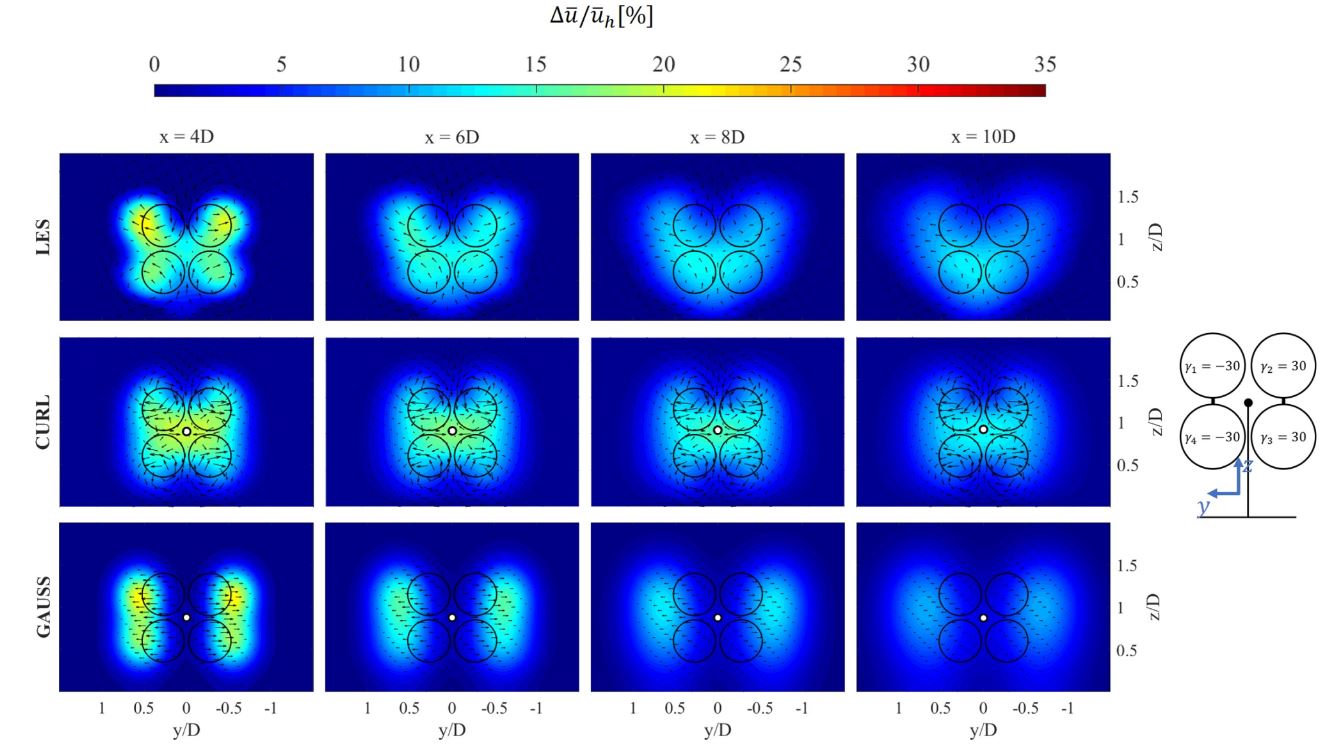Research journal articles published by our students in their capstone projects (BEng, MEng and MSc)
We are very proud of the achievements of many of our undergraduate and postgraduate students in their Capstone Projects (MEng, BEng and MSc). Please see below examples of peer reviewed journal articles published in recent years by our students as their research project outcome. Student names are highlighted as bold text in the author list.
2021-2022
Head, S.; Keshavarz Hedayati, M. Inverse Design of Distributed Bragg Reflectors Using Deep Learning. Appl. Sci. 2022, 12, 4877. https://doi.org/10.3390/app12104877
Abstract: Distributed Bragg Reflectors are optical structures capable of manipulating light behaviour, which are formed by stacking layers of thin-film materials. The inverse design of such structures is desirable, but not straightforward using conventional numerical methods. This study explores the application of Deep Learning to the design of a six-layer system, through the implementation of a Tandem Neural Network. The challenge is split into three sections: the generation of training data using the Transfer Matrix method, the design of a Simulation Neural Network (SNN) which maps structural geometry to spectral output, and finally an Inverse Design Neural Network (IDNN) which predicts the geometry required to produce target spectra. The latter enables the designer to develop custom multilayer systems with desired reflection properties. The SNN achieved an average accuracy of 97% across the dataset, with the IDNN achieving 94%. By using this inverse design method, custom-made reflectors can be manufactured in milliseconds, significantly reducing the cost of generating photonic devices and thin-film optics.

2020-2021
Max Albert, Zhiwei Ma, Huashan Bao, Anthony Paul Roskilly, Operation and performance of Brayton Pumped Thermal Energy Storage with additional latent storage, Applied Energy, Volume 312, 2022, https://doi.org/10.1016/j.apenergy.2022.118700.
Abstract: Pumped Thermal Energy Storage (PTES) is an increasingly attractive area of research due to its multidimensional advantages over other grid scale electricity storage technologies. This paper built a model and numerically studied the performance of an Argon based Brayton type PTES system. The model was used to optimise total work output and round-trip efficiency of the system. The aspect ratio of the thermal storage tanks and operation of packed bed segmentation have been varied to assess their impacts on round-trip efficiency. Longer and thinner tanks were found to increase efficiency, with the hot tank length affecting system performance to a greater extent than the cold tank. Larger ‘temperature ratio’ in segmentation operation were found to develop higher round-trip efficiency, with higher exit working fluid temperature from hot storage over a shorter duration demonstrating better performance. Key features describing the power output were identified as the duration of the region of maximum power and the steepness of the ‘power front’. To maximise the duration of the high power region and decrease the width of the power front, additional latent heat storage was used, the effect of which on round-trip efficiency was then assessed with predicted efficiencies of up to 80% using isentropic reciprocating compressor/expander architecture, which is close to the theoretically predicted limit.
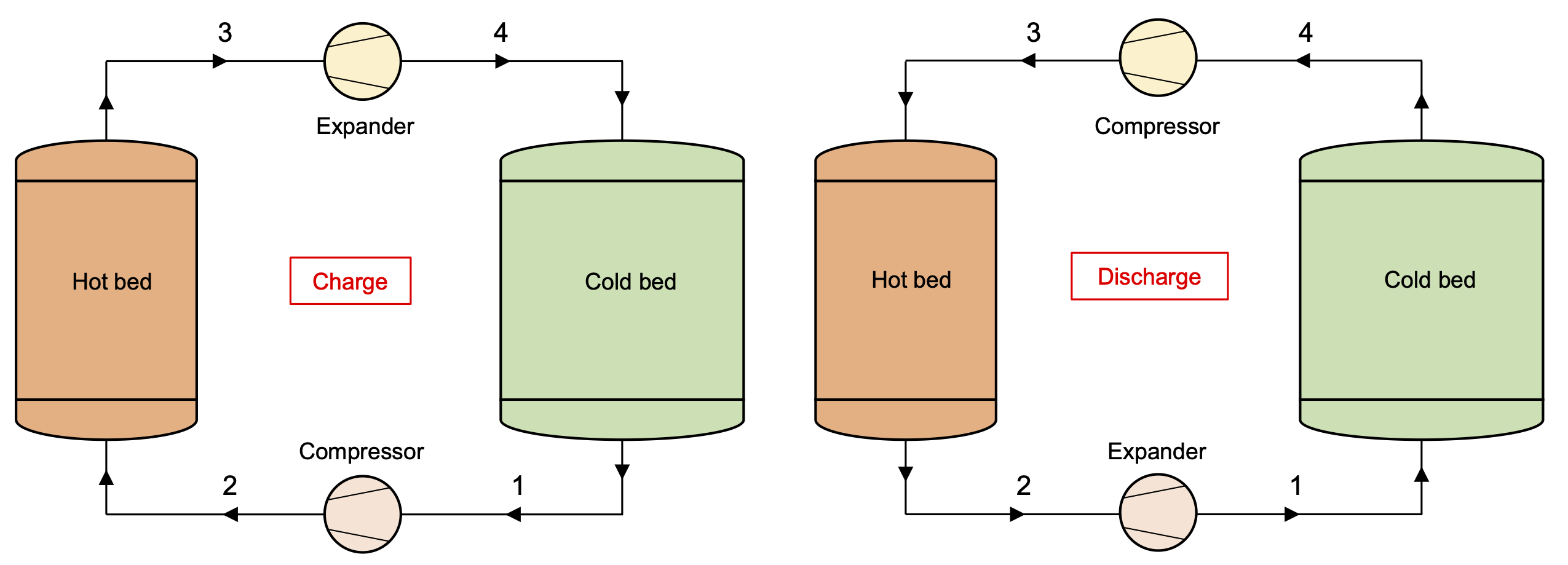
, "A deep learning approach to the forward prediction and inverse design of plasmonic metasurface structural color", Appl. Phys. Lett. 119, 061101 (2021) https://doi.org/10.1063/5.0055733
Abstract: This report details a deep learning approach to the forward and inverse designs of plasmonic metasurface structural color. Here, optimized Deep Neural Network models are presented to enable the forward and inverse mapping between metamaterial structure and corresponding color. The forward model is capable of predicting color with >96% accuracy, with a 105 order of magnitude decrease in computational time when compared to finite-difference time-domain simulations used in conventional design workflows. An inverse model is trained using a tandem autoencoder, employing the pre-trained forward model. Here, the use of synthetic training data for self-learning is reported, which results in an ≈15% improvement in training accuracy. The tightly constrained inverse model allows for the instantaneous design of metasurfaces, given a desired color, with an accuracy of >86%, making it suitable for commercial use as well as the acceleration of photonics research.
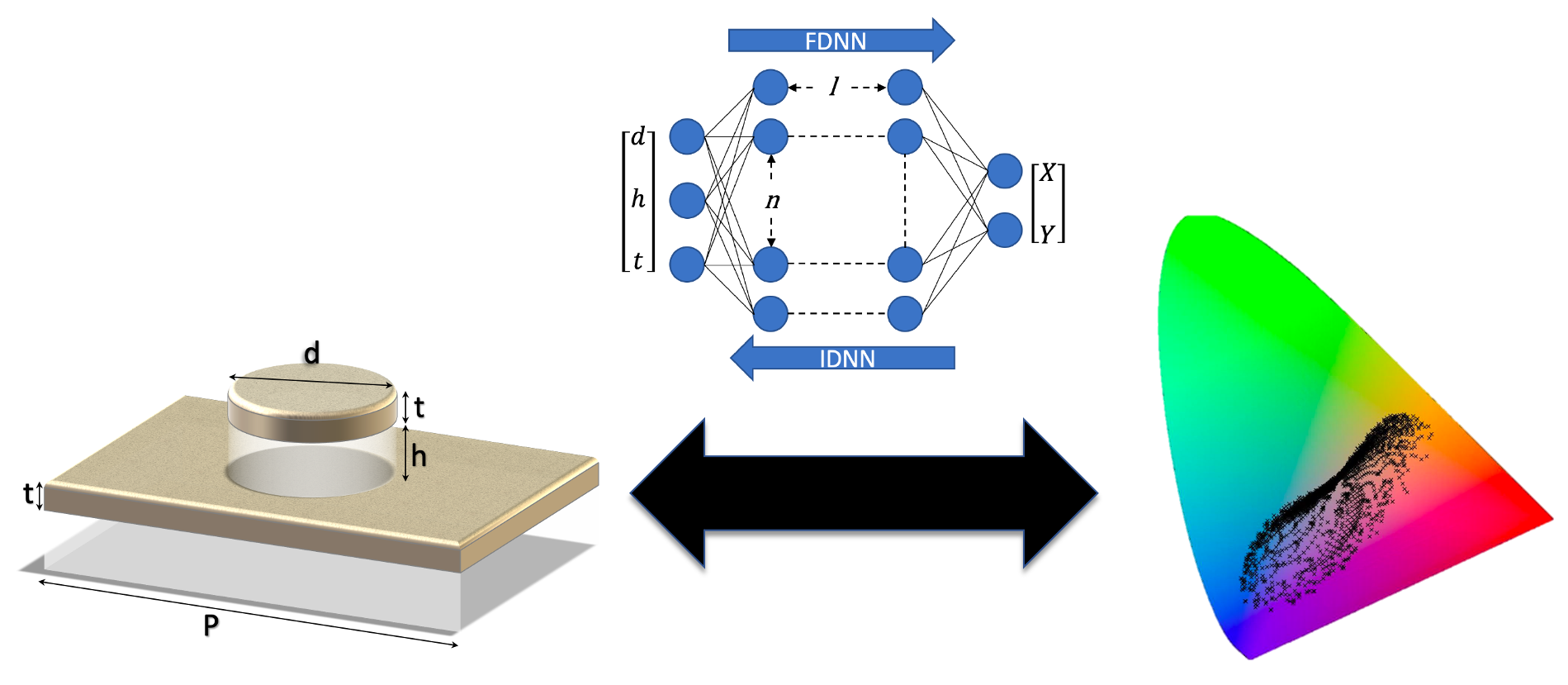
Oxenham, L.; Wang, Y. A Study of the Impact of Methanol, Ethanol and the Miller Cycle on a Gasoline Engine. Energies 2021, 14, 4847. https://doi.org/10.3390/en14164847
Abstract: This paper focuses on the investigation and optimisation of the Miller cycle, methanol, ethanol and turbocharging when applied to a high-performance gasoline engine. These technologies have been applied both individually and concurrently to test for potential compounding effects. Improvements have been targeted with regards to both emission output and performance. Also assessed is the capability of the engine to operate when exclusively powered by biofuels. This has been carried out numerically using the 1D gas dynamics tool ‘WAVE’, a 1D Navier–Stokes equation solver. These technologies have been implemented within the McLaren M838T 3.8L twin-turbo engine. The Miller cycle early intake valve close (EIVC) improved peak efficiency by 0.17% and increased power output at low and medium loads by 11%. Reductions of 6% for both NOx and CO were also found at rated speed. The biofuels achieved NOx and CO reductions of 60% and 96% respectively, alongside an efficiency increase of 2.5%. Exclusive biofuel use was found to be feasible with a minimum 35% power penalty. Applied cooperatively, the Miller cycle and biofuels were not detrimental to each other, compounding effects of a further 0.05% efficiency and 2% NOx improvements were achieved.
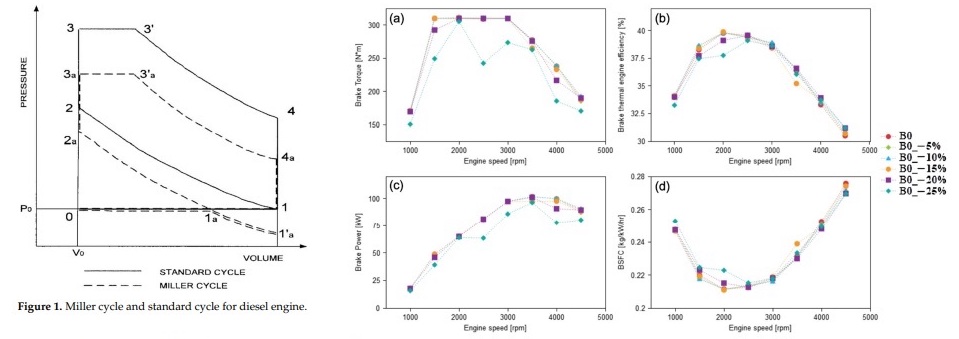
 Student's biography: I have recently completed my Master’s degree in Mechanical Engineering at Durham University and I intend to pursue a career developing progressive vehicular technology, with an emphasis on a sustainable and carbon-neutral global future. I have been awarded the BDAE Scholarship and ‘Best of the Best’ Young Engineer Awards and have been named a Cumbrian Young Physicist of the Year by the Ogden Trust. I have past experience working with lighting and optics for military vehicles at Oxley Developments UK and I have gained a variety of practical composite skills following time spent with Durham’s solar car team.
Student's biography: I have recently completed my Master’s degree in Mechanical Engineering at Durham University and I intend to pursue a career developing progressive vehicular technology, with an emphasis on a sustainable and carbon-neutral global future. I have been awarded the BDAE Scholarship and ‘Best of the Best’ Young Engineer Awards and have been named a Cumbrian Young Physicist of the Year by the Ogden Trust. I have past experience working with lighting and optics for military vehicles at Oxley Developments UK and I have gained a variety of practical composite skills following time spent with Durham’s solar car team.
Dominic Burrin, Sumit Roy, Anthony Paul Roskilly, Andrew Smallbone, A combined heat and green hydrogen (CHH) generator integrated with a heat network, Energy Conversion and Management, Volume 246, 2021, https://doi.org/10.1016/j.enconman.2021.114686.
Abstract: Combined heat and power (CHP) systems offer high energy efficiencies as they utilise both the electricity generated and any excess heat by co-suppling to local consumers. This work presents the potential of a combined heat and hydrogen (CHH) system, a solution where Proton exchange membrane (PEM) electrolysis systems producing hydrogen at 60–70% efficiency also co-supply the excess heat to local heat networks. This work investigates the method of capture and utilisation of the excess heat from electrolysis. The analysed system was able to capture 312 kW of thermal energy per MW of electricity and can deliver it as heated water at either 75 °C or 45 °C this appropriate for existing district heat networks and lower temperature heat networks respectively. This yields an overall CHH system efficiency of 94.6%. An economic analysis was conducted based on income generated through revenue sales of both hydrogen and heat, which resulted in a significant reduction in the Levelized Cost of Hydrogen.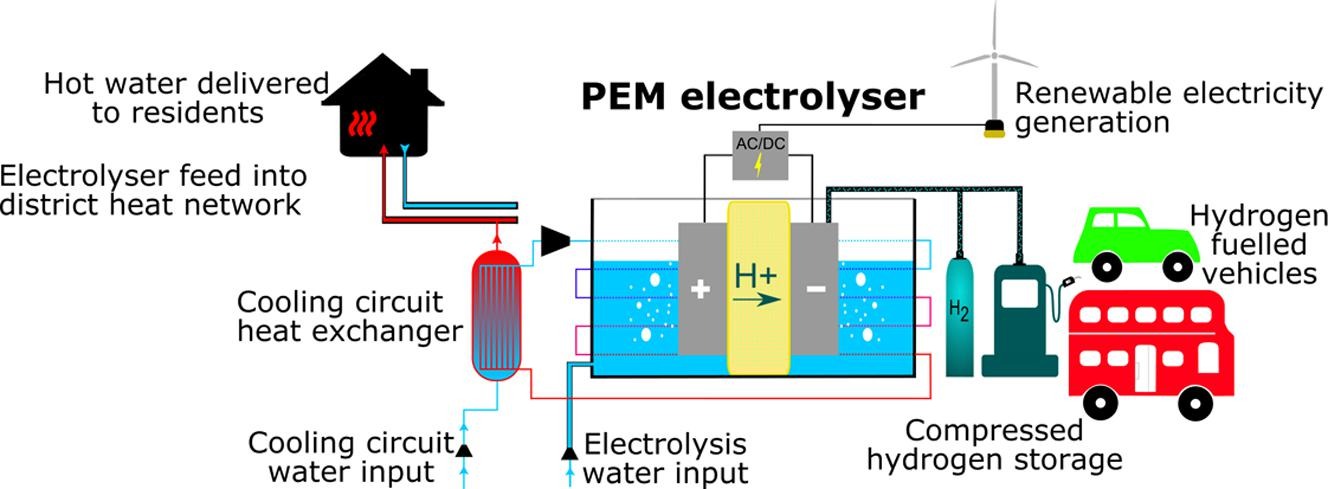
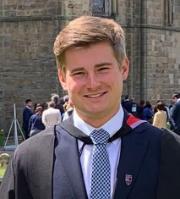 Student's biography: I graduated from Durham in June 2021 after a brilliant 4 years studying Aeronautical Engineering. Working with Andy and Sam on this paper was a particular highlight of my studies with the Department. Not only did I get to learn about and explore a novel concept in detail, but was fortunate enough to have the paper published in “Energy Conversion and Management”. My final year project followed on nicely from the research I did with Andy in summer 2020 which focussed on the decarbonisation of heating and cooling in the UK. I’d like to say thanks to all the staff in the Engineering Department that made my time so enjoyable and I hope to be back in Durham to visit in the not too distant future.
Student's biography: I graduated from Durham in June 2021 after a brilliant 4 years studying Aeronautical Engineering. Working with Andy and Sam on this paper was a particular highlight of my studies with the Department. Not only did I get to learn about and explore a novel concept in detail, but was fortunate enough to have the paper published in “Energy Conversion and Management”. My final year project followed on nicely from the research I did with Andy in summer 2020 which focussed on the decarbonisation of heating and cooling in the UK. I’d like to say thanks to all the staff in the Engineering Department that made my time so enjoyable and I hope to be back in Durham to visit in the not too distant future.
Max Patel, Sumit Roy, Anthony Paul Roskilly, Andrew Smallbone, The techno-economics potential of hydrogen interconnectors for electrical energy transmission and storage, Journal of Cleaner Production, Volume 335, 2022, https://doi.org/10.1016/j.jclepro.2021.130045.
Abstract: This research introduces a ‘Hydrogen Interconnector System’ (HIS) as a novel method for transporting electrical energy over long distances. The system takes electricity from stranded renewable energy assets, converts it to hydrogen in an electrolyser plant, transports hydrogen to the demand centre via pipeline, where it is reconverted to electricity in either a gas turbine or fuel cell plant. This paper evaluates the competitiveness of the technology with High Voltage Direct Current (HVDC) systems, calculating the following techno-economic indicators; Levelised Cost Of Electricity (LCOE) and Levelised Cost Of Storage (LCOS). The results suggest that the LCOE of the HIS is competitive with HVDC for construction in 2050 with distance beyond 350 km in case of all scenarios for a 1 GW system. The LCOS is lower than an HVDC system using large scale hydrogen storage in 6 out of 12 scenarios analysed, including for construction from 2025. The HIS was also applied to three case studies, with the results showing that the system outperforms HVDC from LCOS perspectives in all cases, and has 15%–20% lower investment costs in 2 studies analysed.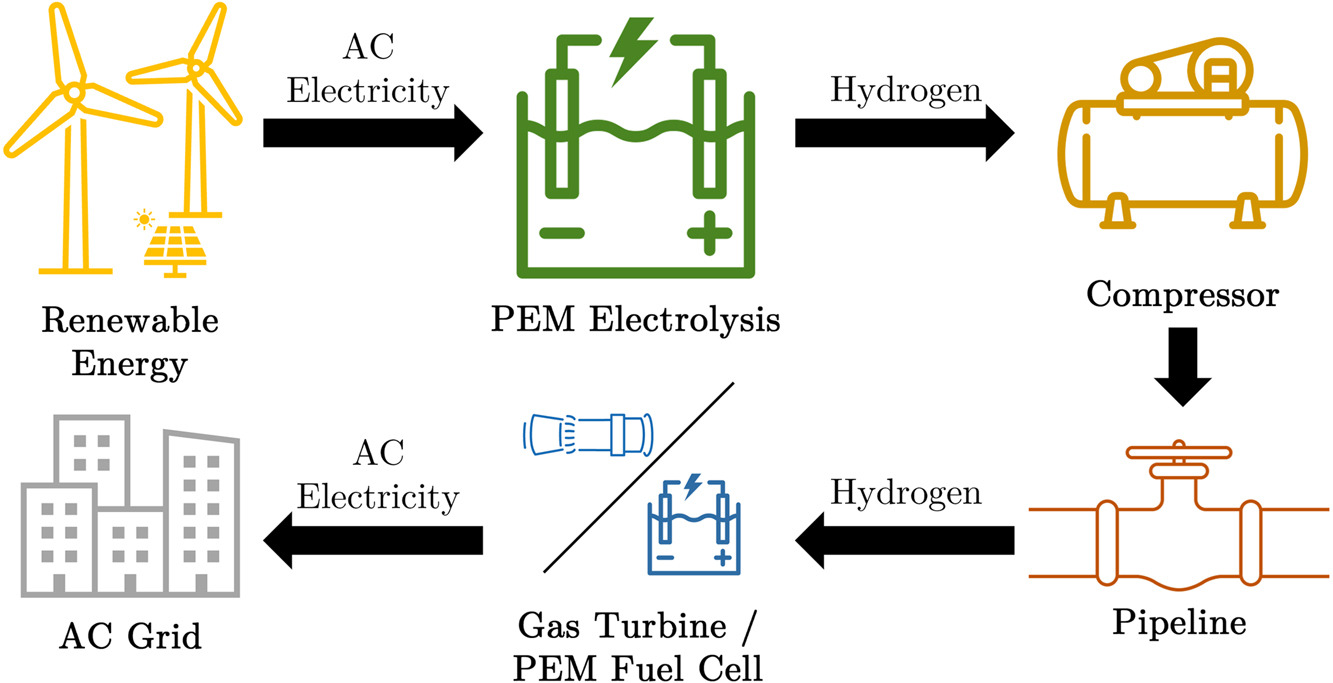
 Student's biography: Max graduated from Durham University in 2021 with a first class degree in Renewable Energy Engineering. For his final year project, he modelled the techno-economics of hydrogen interconnectors, to establish whether the technology could be cost competitive with long distance electricity transport in direct current (DC) cables. He carried out scenario analysis in an Excel model, and produced an accompanying report which was published in the Journal of Cleaner Production in early 2022. Since graduating, Max joined Jacobs Solutions Inc. as a Carbon and Energy consultant, where he has continued working in the hydrogen space.
Student's biography: Max graduated from Durham University in 2021 with a first class degree in Renewable Energy Engineering. For his final year project, he modelled the techno-economics of hydrogen interconnectors, to establish whether the technology could be cost competitive with long distance electricity transport in direct current (DC) cables. He carried out scenario analysis in an Excel model, and produced an accompanying report which was published in the Journal of Cleaner Production in early 2022. Since graduating, Max joined Jacobs Solutions Inc. as a Carbon and Energy consultant, where he has continued working in the hydrogen space.
2019-2020
Bastankhah, M., Welch, B., Martínez-Tossas, L., King, J., & Fleming, P. (2021). Analytical solution for the cumulative wake of wind turbines in wind farms. Journal of Fluid Mechanics, 911, A53. doi:10.1017/jfm.2020.1037
Abstract: This paper solves an approximate form of conservation of mass and momentum for a turbine in a wind farm array. The solution is a fairly simple explicit relationship that predicts the streamwise velocity distribution within a wind farm with an arbitrary layout. As this model is obtained by solving flow-governing equations directly for a turbine that is subject to upwind turbine wakes, no ad hoc superposition technique is needed to predict wind farm flows. A suite of large-eddy simulations (LES) of wind farm arrays is used to examine self-similarity as well as validity of the so-called conservation of momentum deficit for turbine wakes in wind farms. The simulations are performed with and without the presence of some specific turbines in the wind farm. This allows us to systematically study some of the assumptions made to develop the analytical model. A modified version of the conservation of momentum deficit is also proposed to provide slightly better results at short downwind distances, as well as in the far wake of turbines deep inside a wind farm. Model predictions are validated against the LES data for turbines in both full-wake and partial-wake conditions. While our results highlight the limitation in capturing the flow speed-up between adjacent turbine columns, the model is overall able to acceptably predict flow distributions for a moderately sized wind farm. Finally, the paper employs the new model to provide insights on the accuracy of common wake superposition methods.
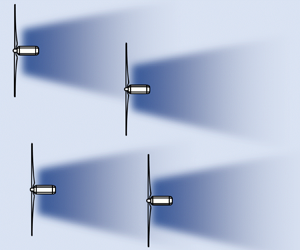
 Student's biography: Bridget is a Mechanical Engineer at PDL Group, an engineering consultancy based in Hexham, working on a variety of projects within highly regulated industries such as renewables, nuclear and pharmaceutical. Bridget graduated from the University of Bristol with 1st class honours in Mathematics and Physics, following which she enrolled on the Teach First Leadership Development Programme, teaching secondary school Mathematics for two years. Bridget returned to the classroom afterwards for an MSc in New and Renewable Energy at Durham University, during which she co-authored a paper alongside her supervisor, Majid Bastankhah, published in the Journal of Fluid Mechanics.
Student's biography: Bridget is a Mechanical Engineer at PDL Group, an engineering consultancy based in Hexham, working on a variety of projects within highly regulated industries such as renewables, nuclear and pharmaceutical. Bridget graduated from the University of Bristol with 1st class honours in Mathematics and Physics, following which she enrolled on the Teach First Leadership Development Programme, teaching secondary school Mathematics for two years. Bridget returned to the classroom afterwards for an MSc in New and Renewable Energy at Durham University, during which she co-authored a paper alongside her supervisor, Majid Bastankhah, published in the Journal of Fluid Mechanics.
, , , . Wake steering of multirotor wind turbines. Wind Energy. 2021; 24(11): 1294- 1314. https://doi.org/10.1002/we.2633
Abstract: In this paper, wake steering is applied to multirotor turbines to determine whether it has the potential to reduce wind plant wake losses. Through application of rotor yaw to multirotor turbines, a new degree of freedom is introduced to wind farm control such that wakes can be expanded, channelled or redirected to improve inflow conditions for downstream turbines. Five different yaw configurations are investigated (including a baseline case) by employing large-eddy simulations (LES) to generate a detailed representation of the velocity field downwind of a multirotor wind turbine. Two lower-fidelity models from single-rotor yaw studies (curled-wake model and analytical Gaussian wake model) are extended to the multirotor case, and their results are compared with the LES data. For each model, the wake is analysed primarily by examining wake cross-sections at different downwind distances. Further quantitative analysis is carried out through characterisations of wake centroids and widths over a range of streamwise locations and through a brief analysis of power production. Most significantly, it is shown that rotor yaw can have a considerable impact on both the distribution and magnitude of the wake velocity deficit, leading to power gains for downstream turbines. The lower-fidelity models show small deviation from the LES results for specific configurations; however, both are able to reasonably capture the wake trends over a large streamwise range.
 Student's biography: I graduated from Durham in 2020 with an MEng in Aeronautics and went on to publish my dissertation entitled Wake Steering of Multirotor Wind Turbines in the journal of Wind Energy. During my final year I worked with a fantastic team of academics from the UK, US, and Denmark, developing wind turbine aerodynamics models to investigate methods for improving the power production and efficiency of wind farms. These days I work for a consultancy that focuses on decarbonisation strategy, where I use the skills I learnt at Durham to develop techno-economic energy system models that enable our clients to facilitate the low carbon transition.
Student's biography: I graduated from Durham in 2020 with an MEng in Aeronautics and went on to publish my dissertation entitled Wake Steering of Multirotor Wind Turbines in the journal of Wind Energy. During my final year I worked with a fantastic team of academics from the UK, US, and Denmark, developing wind turbine aerodynamics models to investigate methods for improving the power production and efficiency of wind farms. These days I work for a consultancy that focuses on decarbonisation strategy, where I use the skills I learnt at Durham to develop techno-economic energy system models that enable our clients to facilitate the low carbon transition.
Gbinigie, Henrike Coats, Louise Parikh, Jehill Hollingsworth, Kieren & Gan, Lian (2021). A 4D-flow cardiovascular magnetic resonance study of flow asymmetry and haemodynamic quantity correlations in the pulmonary artery. Physiological Measurement 42(2): 025005. https://doi.org/10.1088/1361-6579/abdf3b
Abstract: Objective. In this paper we elucidate the asymmetric flow pattern and the haemodynamic quantity distributions and correlations in the pulmonary artery (PA) vasculature in healthy adults having structurally normal hearts, to provide reference on the flow characteristics in the PA and the right ventricle. Approach. Velocity data are acquired non-invasively from 18 healthy volunteers by 4D flow magnetic resonance imaging, resolved to 20 phases with spatial resolution 3 × 3 × 3 mm3. Interpolation is applied to improve the accuracy in quantifying haemodynamic quantities including kinetic energy, rotational energy, helicity and energy dissipation rate. These quantities are volumetrically normalised to remove size dependency, representing densities or local intensity. Main results. Flow asymmetry in the PA is quantified in terms of all the flow dynamic quantities and their correlations. The right PA has larger diameter and higher peak stroke velocity than the left PA. It also has the highest rotational energy intensity. Counter-rotating helical streams in the main PA appear to be associated with the unidirectional helical flow noticed in the left and the right PA near the peak systole. Significance. This study provides a fundamental basis of normal flow in the PA. It implies the validity to use these flow pattern-related quantitative measures to aid with the identification of abnormal PA flow non-invasively, specifically for detecting abnormalities in the pulmonary circulation and response to therapy, where haemodynamic flow is commonly characterised by increased vortical and helical formations.
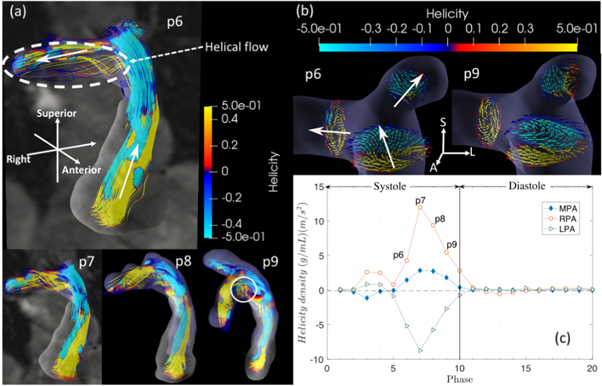
2018-2019
Dewhurst, Peter,, Coats, Louise,, Parikh, Jehill D,, Hollingsworth, Kieren G, & Gan, Lian (2020). The role of flow rotation in the adult right atrium: a 4D flow cardiovascular magnetic resonance study. Physiological Measurements 41(3): 035007. https://doi.org/10.1088/1361-6579/ab7d77
Abstract: Objective: In healthy adults, the right atrium (RA) serves as a reservoir for the systemic flow return from the superior vena cava (SVC) and inferior vena cava (IVC), preparing the two flows to be transferred to the right ventricle (RV) and pulmonary circulation. This study aims to quantify the haemodynamics of the RA and the associated SVC and IVC inflows, which have not been fully understood to date. Approach: Eighteen adults with structurally normal hearts underwent 4D flow magnetic resonance imaging. The cardiac cycle was resolved to 20 temporal phases with a spatial resolution of 3 × 3 × 3 mm3. Analysis included objective visualisation of the flow structures in the RA identified by three different vortex identification criteria, kinetic energy (KE), enstrophy and dissipation. KE and helicity flux were also assessed in both caval veins. Main results: Vortex identification methods confirmed that in the majority of participants the blood flow from the caval veins filling the RA during ventricular systole is not chaotic, but rather forms an organised pattern of a single coherent forward turning vortex structure. Thirteen participants displayed a single vortex flow structure, four showed multiple vortices and one had a helical flow pattern without a clear vortex structure. A strong positive correlation exists between the flow KE and enstrophy density. Significance: This suggests that flow energy in the RA is mainly rotational, part of which is convected by the highly helical SVC and IVC inflows. Multiple vortices tend to be associated with higher dissipation rates in the central RA region due to turbulence. The rotational nature of the flow in the RA maintains KE better than non-rotational flow. RA flow characteristics are highly related to the helicity content in the caval veins, as well as the KE flux intensity. Lower caval helicity or IVC KE flux dominance tends to favour single vortex formation while the opposite tends to lead to multiple vortices or the rare helical flow patterns. Atria lacking single vortex flow are inclined to have a larger energy input from atrial contraction.
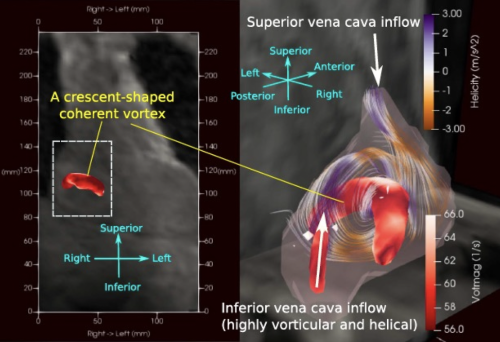
Hollands, E.O., He, C. & Gan, L. A particle image velocimetry study of dual-rotor counter-rotating wind turbine near wake. J Vis 23, 425–435 (2020). https://doi.org/10.1007/s12650-020-00643-0
Abstract: This experimental work studied the flow characteristics in the near wake region behind dual-rotor wind turbines using two-dimensional particle image velocimetry. Two auxiliary rotors of 50% and 80% scale of the main rotor were installed upwind and operated in counter-rotating condition, which are compared to the conventional single-rotor turbine. In all the three configurations, a constant Reynolds number 95000 was applied, and all the rotors operated at a fixed tip speed ratio of 3.46. The mean and phase-averaged velocity fields were investigated together with the turbulence kinetic energy. It was found that the two auxiliary rotors do not result in a significantly different wake flow property. The configuration implementing the 50% auxiliary rotor sees a slightly better wake characteristics, in terms of weaker main rotor tip vortices and a counter-rotating swirling shear region at the mid-span behind the main rotor. The decay rates of the peak vorticity of the main rotor tip vortices and their circulation are found to follow an exponential manner.



/prod01/prodbucket01/media/durham-university/departments-/engineering/74202-5112X1676.jpg)
/prod01/prodbucket01/media/durham-university/departments-/engineering/graphical_abstract_MEHDI-KESHAVARZ-HEDA.png)
/prod01/prodbucket01/media/durham-university/departments-/engineering/StProjPatel.jpg)
/prod01/prodbucket01/media/durham-university/departments-/engineering/StProjGbinigie.jpeg)
/prod01/prodbucket01/media/durham-university/departments-/engineering/StProjDewhurst-500X342.png)
